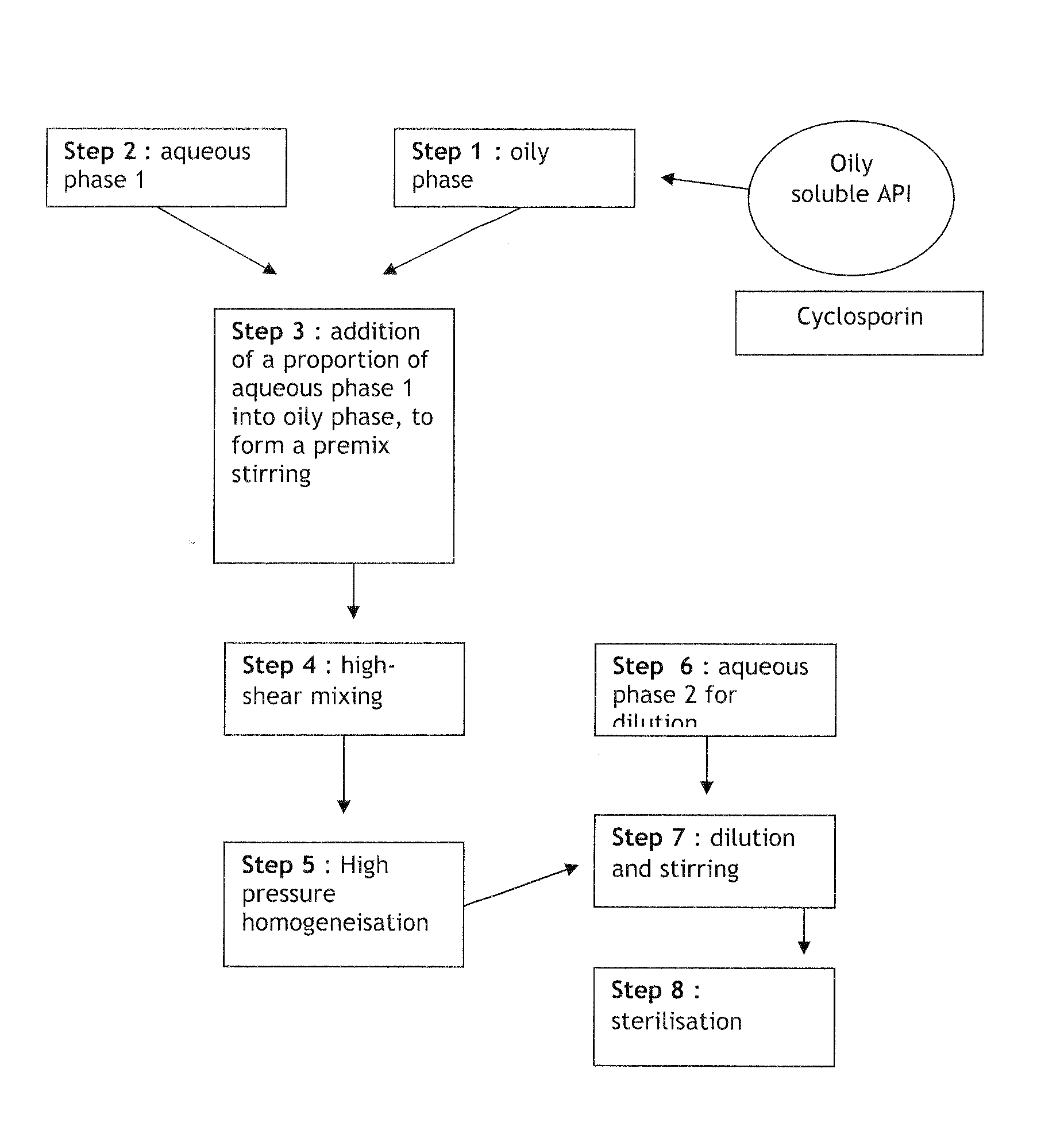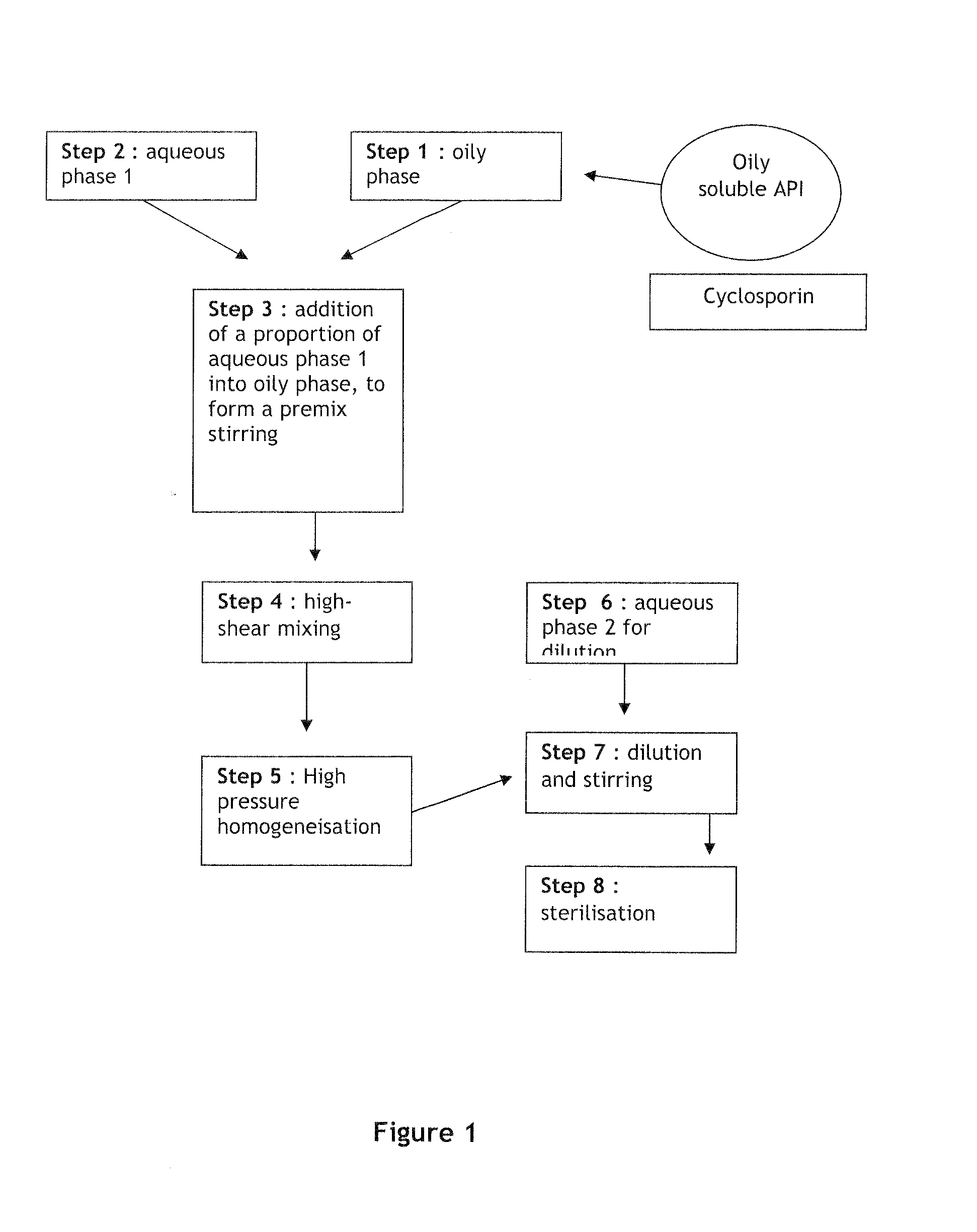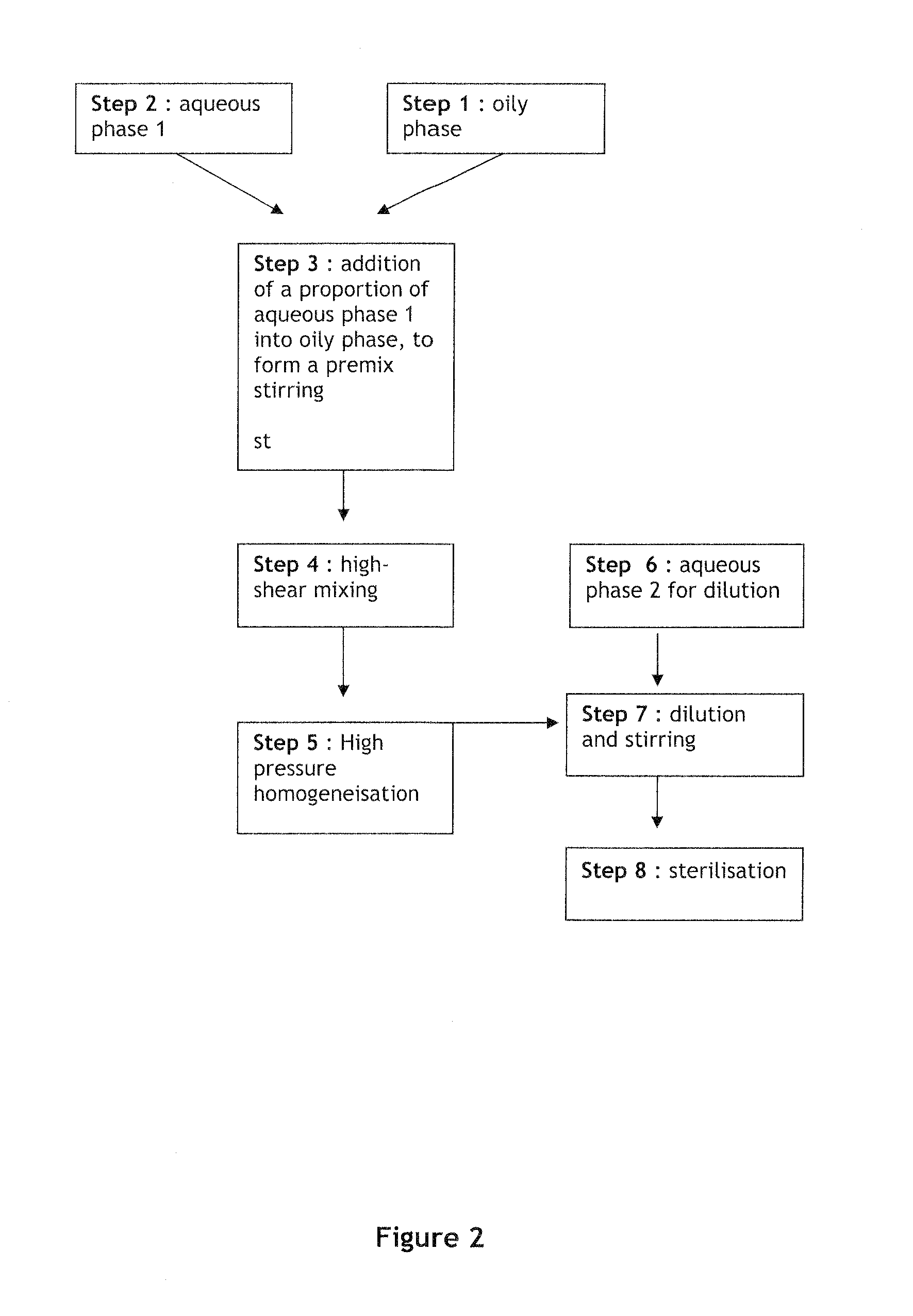Process for manufacturing ophthalmic oil-in-water emulsions
a technology of ophthalmic oil and water emulsion, which is applied in the direction of peptide/protein ingredients, dna/rna fragmentation, depsipeptides, etc., can solve the problems of high oil concentration, time and energy consumption, and high cost of capital equipment, so as to achieve reasonable processing time, reduce the effect of toxicity and high yield
- Summary
- Abstract
- Description
- Claims
- Application Information
AI Technical Summary
Benefits of technology
Problems solved by technology
Method used
Image
Examples
example 1
Preparation of One Batch of 100 kg of an Emulsion Comprising Cyclosporine A
1—Composition
[0101]The following table presents the composition of the Cyclosporine A emulsion.
Unit formulaBatch formulaQuantityQuantity in mg for aQuantity in g forChemical name ingredient% (w / w)300 μL single use viala 100 kg batchOilyExcipients:phaseMCT2.006.002 000 Tyloxapol0.300.90300Active ingredient:Ciclosporin A0.100.30100Total2.407.202 400 AqueousExcipients:phasePoloxamer 1880.100.30100Glycerin2.256.752 250 BAK0.020.06 20WFI95.23285.6995 230 Total97.60292.8097 600 Excipients used duringproduction:Sodium hydroxide 0.1NQSQSQSpH 7.0 ± 0.5pH 7.0 ± 0.5pH 7.0 ± 0.5Nitrogen / / /
2—Compounding Process
[0102]FIG. 1 presents a scheme of the compounding process used in the preparation. In steps 1, 2, and 6, each phase was prepared separately including the API in the oily phase. The aqueous phase and oil phase obtained in steps 1 and 2 were then then diluted to get a premix (w / w) in step 3. The resulting premix ...
example 2
Preparation of One Batch of 500 kg of an Emulsion that does not Comprise API
1—Composition
[0104]The following table presents the composition of the Cyclosporine A emulsion.
Unit formulaBatch formulaQuantityQuantity in mg for aQuantity in g forChemical name ingredient% (w / w)400 μL single use viala 500 kg batchOilyExcipients:phaseHeavy mineral oil0.5002.0002 500Light mineral oil0.5002.0002 500Tyloxapol0.3001.2001 500Cationic agent0.0020.008 10Total1.3025.2086 510AqueousExcipients:phasePoloxamer 1880.1000.400 500Mannitol3.30013.20016 500Tromethamine0.0060.024 30Tris hydrochloride0.0710.284 355WFI95.221380.884476 105 Total98.698394.792493 490 Nitrogen / / /
2—Compounding Process
[0105]FIG. 2 presents a scheme of the compounding process used in the preparation. In steps 1, 2 and 6, each phase was prepared separately. The aqueous phase and oil phase obtained in steps 1 and 2 were then diluted to get a premix (w / w) in step 3. The resulting premix was submitted to a high-shear mixing for about...
example 3
Preparation of One Batch of 100 kg of an Emulsion Comprising Naphazolin
1—Composition
[0107]The following table presents the composition of the Naphazolin emulsion.
Unit formulaBatch formulaQuantityQuantity in mg for aQuantity in g forChemical name ingredient% (w / w)300 μL single use viala 100 kg batchOilyExcipients:phaseCastor oil1.0003.0001 000Tyloxapol0.3000.900 300Propylene glycol1.0003.0001 000Total2.3006.9002 300AqueousExcipients:phasePoloxamer 1880.1000.300 100Glycerin2.2506.7502 250Cationic agent0.0080.024 8WFI95.312285.93695 312 Active ingredient:Naphazolin0.0300.090 30Total97.700293.10097 700 Excipients used duringproduction:Sodium hydroxide 0.1NQS pH 6.0 ± 1QS pH 6.0 ± 1QS pH 6.0 ± 1Nitrogen / / /
2—Compounding Process
[0108]FIG. 3 presents a scheme of the compounding process used in the preparation. In steps 1, 2 and 6, each phase was prepared separately. The API was included in the aqueous phase. The aqueous phase and oil phase obtained in steps 1 and 2 were then diluted to...
PUM
| Property | Measurement | Unit |
|---|---|---|
| mean size | aaaaa | aaaaa |
| mean size | aaaaa | aaaaa |
| mean size | aaaaa | aaaaa |
Abstract
Description
Claims
Application Information
 Login to View More
Login to View More - R&D
- Intellectual Property
- Life Sciences
- Materials
- Tech Scout
- Unparalleled Data Quality
- Higher Quality Content
- 60% Fewer Hallucinations
Browse by: Latest US Patents, China's latest patents, Technical Efficacy Thesaurus, Application Domain, Technology Topic, Popular Technical Reports.
© 2025 PatSnap. All rights reserved.Legal|Privacy policy|Modern Slavery Act Transparency Statement|Sitemap|About US| Contact US: help@patsnap.com



